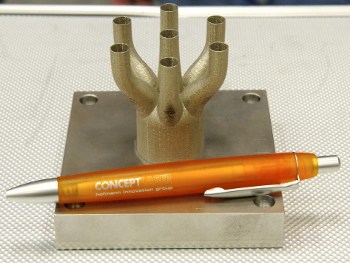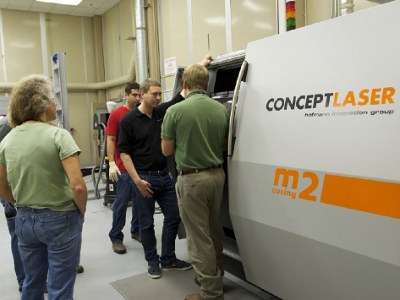 |
| February 05, 2013 | Volume 09 Issue 05 |
Designfax weekly eMagazine
Archives
Partners
Manufacturing Center
Product Spotlight
Modern Applications News
Metalworking Ideas For
Today's Job Shops
Tooling and Production
Strategies for large
metalworking plants
Engineer's Toolbox:
NASA uses selective laser melting to build next-gen rocket components
By Bill Hubscher, NASA's Marshall Space Flight Center

First test piece produced on the M2 Cusing Machine at the Marshall Center. [Image: NASA/MSFC/Andy Hardin]
NASA's Marshall Space Flight Center in Huntsville, AL, is using a method called selective laser melting, or SLM, to create intricate metal parts for America's next heavy-lift rocket. Using this state-of-the-art technique will benefit the agency by saving millions in manufacturing costs.
NASA is building the Space Launch System or SLS -- a rocket managed at the Marshall Center and designed to take humans, equipment, and experiments beyond low-Earth orbit to nearby asteroids and eventually to Mars.
SLM is similar to 3D printing and is the future of manufacturing.
"Basically, this machine takes metal powder and uses a high-energy laser to melt it in a designed pattern," says Ken Cooper, advanced manufacturing team lead at the Marshall Center. "The laser will layer the melted dust to fuse whatever part we need from the ground up, creating intricate designs. The process produces parts with complex geometries and precise mechanical properties from a three-dimensional computer-aided design."
There are two major benefits to this process, which are major considerations for the Space Launch System Program: savings and safety.

Engineers at Marshall Space Flight Center observe the new Selective Laser Melting machine. [Image: NASA/MSFC/Andy Hardin]
"This process significantly reduces the manufacturing time required to produce parts from months to weeks or even days in some cases," says Andy Hardin, the integration hardware lead for the Engines Office in SLS. "It's a significant improvement in affordability, saving both time and money. Also, since we're not welding parts together, the parts are structurally stronger and more reliable, which creates an overall safer vehicle."
The emerging technology will build parts for America's next flagship rocket more affordably and efficiently, while increasing the safety of astronauts and the workforce. Some of the "printed" engine parts will be structurally tested and used in hot-fire tests of a J-2X engine later this year. The J-2X will be used as the upper-stage engine for the SLS.
The goal is to use selective laser melting to manufacture parts on the first SLS test flight in 2017.
The agency procured the M2 Cusing machine, built by Concept Laser (a division of Hoffman Innovation Group of Lichtenfels, Germany) to perform the selective laser manufacturing.
You can watch a video of the SLM machine and see it in action below.
About the process (from Hofmann Innovation)
Hofmann Innovation's term "LaserCUSING" is a combination of the "C" in CONCEPT LASER and the term FUSING (for melting completely). The melting technique generates components layer by layer using 3D CAD data. This generative technique permits the production of complex component geometries without molds, including complex structural geometries which can only be implemented with difficulty using conventional techniques, if at all.
Components can be built in layers from almost any metallic and welding-friendly materials. Single-component metal powder with original material properties is melted completely layer by layer. A component density of almost 100% is achieved. The Concept Laser's "stochastic exposure strategy" ensures a significant reduction of stress in the component, which allows for the distortion-free generation of massive and large-volume components.
The LaserCUSING technique offers:
- Mold-free manufacture of prototypes or small batch series within one to five working days (dependent on volumes);
- Components from original materials with corresponding material properties; and
- Shortening of the development time by saving on waiting times.
LaserCUSING materials include:
- Stainless steel 1.4404 / CL 20ES
- Aluminium alloy AlSi12 / CL 30AL
- Aluminium alloy AlSi10Mg / CL 31AL
- Titanium alloy Ti6Al4V / CL 40TI
- Titanium alloy Ti6Al4V ELI / CL 41TI ELI
- Hot-forming steel 1.2709 / CL 50WS
- Rust-free hot-forming steel CL 91RW
- Nickel-based alloy Inconel 718 / CL 100NB
- Cobalt/chrome alloy remanium star CL
Learn more at www.hofmann-innovation.com.
Sources: NASA, Hoffman Innovation
Published February 2013
Rate this article
View our terms of use and privacy policy
